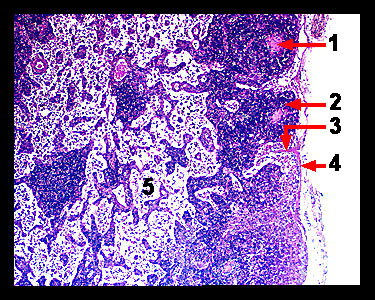|
|
||||||||||||||||||||||||||||||||||||||||||||||||||||||||||||||||||||||||||||||||||||||||||||||||||||||||||||||||||||||||||||||||||||||||||||||||||||||||||||||||||||||||||||||||||||||||||||||||||||||||||||
|
Lymph nodes are small round or bean-shaped structures located at points along the lymphatic vessels. As stated previously, lymph passes or filters through the lymph nodes. The node is surrounded by a fibrous connective tissue capsule. Inward extensions of the capsule (trabeculae) divide the node into several compartments. There are two major regions within the lymph node, the cortex and medulla. The outer cortex consists primarily of numerous lymph nodules separated by diffuse lymphatic tissue, lymph sinuses and trabeculae. The nodules consist primarily of lymphocytes. The lighter stained central region of each nodule is called the germinal center. The germinal centers are areas of rapid lymphocyte division. Newly produced lymphocytes enter the lymph and are carried by the lymphatic vessels back to the venous system where they enter the circulation. The inner medulla of the lymph node appears lighter than the cortex. It consists mainly of macrophages that engulf microorganisms as part of the lymph node's filtering function. |
|
